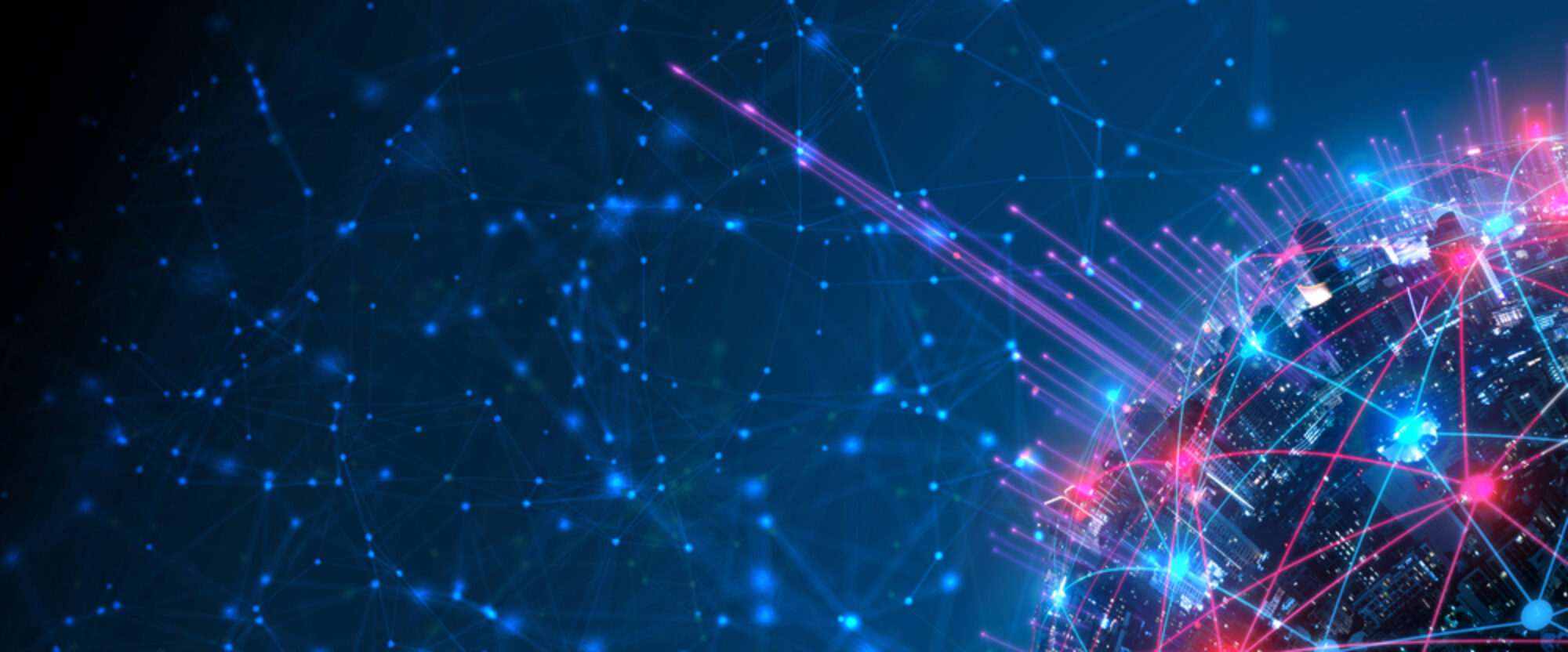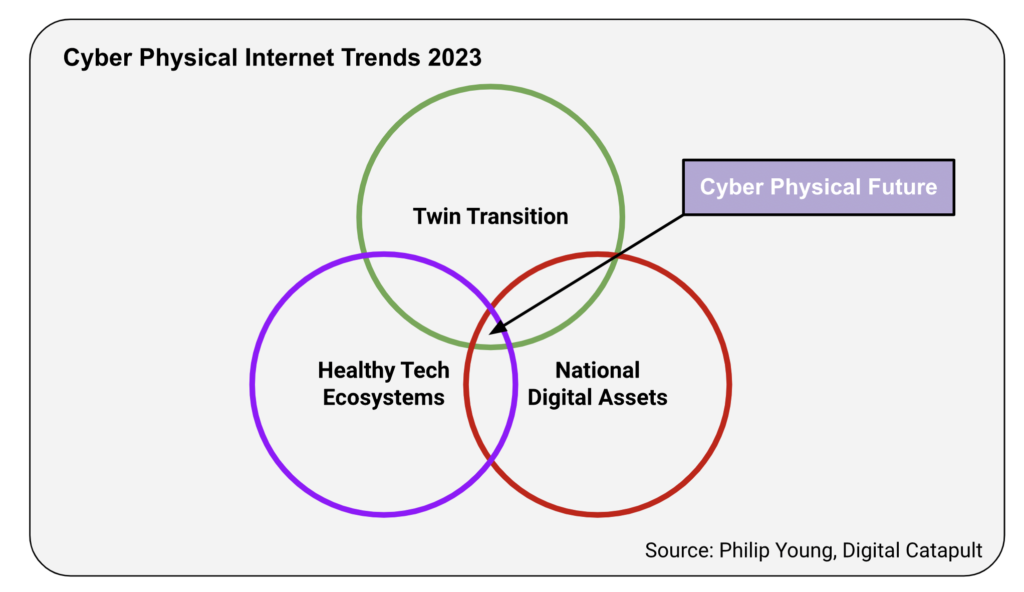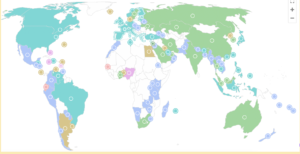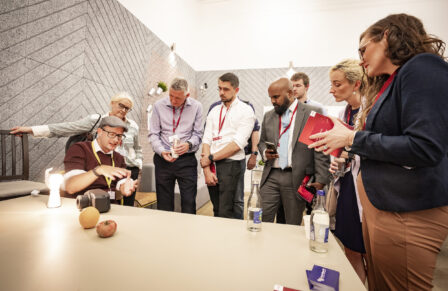Three tech megatrends set to take 2023 by storm
Posted 18 Jan 2023
2023: The global trends of a new cyber physical internet
Looking back at 2022
Last year in our Digital Future Index, Digital Catapult predicted that we would see three big technology themes emerge in 2022; (1) The increased use of remote and autonomous machines (2) The rise of the Metaverse and (3) The journey towards Digital Twins. We were not disappointed to have seen a significant increase in investment and activity in remote operated robotics and complex cyber physical systems, new human machine interaction, a scramble to define what the Metaverse is and can be, and the kicking-off of various industrial Digital Twin initiatives.
Unsurprisingly these themes will continue into 2023 – but what we are starting to see is the transition across the Gartner hype cycle from initial inflated expectations (hype) -> reality vs expectation -> commercialisation and maturity. This leads us to the points below:
- The expansion and battle for market supremacy in our theme areas
- The splintering of those areas into subset areas of activity
- The dismantling / scrutiny of those trends to test if they are “really a thing.”
- At the very top level, where we see most of the jostling for position, we are witnessing the emergence of a new internet that brings the physical and digital worlds together utilising a wide range of advanced digital technologies. From new human machine interaction tools like augmented reality that will layer information over the physical environment, new robotic systems such as drones and autonomous delivery bots, better connectivity using “real” 5G, the data architectures, platforms and models that will underpin complex cyber physical systems such as digital twins. While the focus tends to be on either Digital Twins AND/OR Metaverse (or any other complex systems that might spring up with a new name) – all of these new terms should be considered together under the same umbrella, the architecting of a “Cyber Physical Internet” and the variety of complex considerations that will come with that. This internet might be called the Metaverse in the future, it might be called something else – but it is coming.
When people talk about the premature death of the Metaverse we should therefore be careful. The term Metaverse may or may not stick over the next few years, but what is certain is that a new generation of digitalisation is happening – underpinned by new human machine interaction, advanced visualisation and immersivity, games engines, simulation models, artificial intelligence, blockchain and advanced digital infrastructure. The success of this new phase is reliant on building healthy tech ecosystems for the future, avoiding the business models of the past and balancing the dominance of big tech. Pretending we are already seeing the end of the Metaverse will just lead us to sleepwalk into the same challenges we have faced at each zeitgeist moment of the internet (e.g. the dot com boom, smartphones and the rise of social media engines etc.) and miss the opportunity to build capabilities that work for everyone. We are at a global level undergoing a reimagining of the future of digital technologies and the markets that underpin them, to build a new vision for a cyber physical future.
Looking forward to 2023
It is for this reason that rather than considering breakthrough technologies on their own (of which there are always many, this year OpenAI’s ChatGPT3 and Generative AI for example) – we are likely to see those technologies integrated into and enabling new features of this emerging extension of the internet. The trends we expect to see and are keen to address at Digital Catapult are broader than one set of technologies over another, taking a systems thinking approach to consider how this cyber physical internet will manifest itself, tackle challenges and create new opportunities in 2023 and beyond.
The macro tech innovation trends for this cyber physical internet in 2023:
- National scale advanced digital technology assets: 2023 will kick start the development of large national advanced digital technology assets and architectures. This will include the development of high profile Central Bank Digital Currencies (CBDC), national digital twins and data architectures, testbeds for the real world metaverse and web3, and digital critical national infrastructures for a cyber physical internet.
- A drive towards healthier advanced tech ecosystems for the future: This year will see the encouragement of better business models for technology ecosystems, including trust & transparency, interoperability and openness by design. Ensuring that we move beyond considering just the ethics of technologies – to the sustainability, resilience and diversification of the technology supply side at a national and international level.
- The Twin Transition of Digital & Sustainability: Digital and sustainability strategies will become entwined, underpinned by digital twins and sustainability data – utilising shared interests from across the public and private sectors to drive goals.

National scale advanced digital technology assets
In 2023 we will start to see an increasing focus on building advanced digital technology enabled national assets and a shift to considering digital technology architectures as part of critical national infrastructure. We are already starting to see these trends emerge in a number of ways. The first major example is that countries around the world are doubling down on their efforts to create central bank digital currencies (CBDC). According to Atlantic Council’s research and tracking, there are currently 114 countries, representing 95%+ of global GDP, exploring the development of CBDC’s, with 60 of those in advanced stages of development.
Atlantic Council suggests that in 2023, over 20 countries will take significant steps towards piloting a CBDC. Australia, Thailand, Brazil, India, South Korea and Russia intend to continue or begin pilot testing. The European Central Bank is also likely to start a pilot this year, and as of December 2022, all G7 economies have now moved into the development stage of a CBDC, including the US. With Rishi Sunak a big proponent of digital currencies we would expect to see the UK taking a leading role in this space over the course of the year.
 Map of CBDC’s from the Atlantic Council – Central Bank Digital Currency Tracker (2023)
Map of CBDC’s from the Atlantic Council – Central Bank Digital Currency Tracker (2023)
This renewed interest in digital currency will push the market forward – including how blockchain and distributed ledger technologies (DLT) will be considered as a key enabler for digital innovation and move more into the mainstream, through legitimate and high profile use cases across businesses. This includes Web3 as we start to think about how DLT can be integrated into the development of a cyber physical internet. Web3, using distributed ledger technologies will ensure that we move away from centralised control and ownership of large parts of the internet by large entities, to instead ensure that ownership gets distributed across a wider range of actors, countries, businesses, developers and users. Web3 / DLT and a renaissance around the Internet of Things, combined with artificial intelligence and advanced networks are considered to be the underpinning cyber physical internet infrastructure of the future.
The UK has taken significant steps forward in this area, with the launch of the consultation around Cyber Physical Infrastructure in 2022 – and the expectation of next steps and announcements in this and the digital twins area from the UK government over the course of this year, in line with activities in numerous other countries. As part of this digital assets and architectures will begin to be seen as part of a critical national infrastructure that may be owned by the state but designed, built and operated by the industries that will use them (e.g. digital twin data architectures for energy systems or for climate change). Watch this space as the desire for technology and economic national resilience becomes more mainstream.
A drive towards healthier emerging technology ecosystems of the future
Greater national resilience in technology development and use is also part of a wider set of ambitions and goals that will continue to develop over the next year and beyond, as countries look to prioritise initiatives that promote healthier technology ecosystems both within and beyond national borders. This means reducing reliance on big tech companies, more sustainable business models and more proactive planning for how we monitor, develop and regulate emerging technologies. This includes promotion of interoperability and openness between different platforms, and identifying how we can diversify the supply chains of digital technologies.
Greater market readiness of emerging technologies such as ChatGPT and Generative AI, a type of artificial intelligence (AI) that is able to generate new, original content based on a set of input parameters, has the potential to revolutionise a number of fields, including the creative industries, product design, medical research, and marketing and advertising. These advances will lead to increased and renewed concerns about how we regulate AI and protect jobs in the face of these new capabilities, while also considering how we can use these technologies as tools for the benefit of everyone. Getty Images for example have recently challenged the legalities of generative AI, by taking the company behind popular AI content creator tool Stable Diffussion to court. This regulatory battle will also play out alongside the drive for new skills and new types of jobs. These jobs will need to leverage these emerging technologies, and will increasingly become important, with design, creativity, innovation, human-machine interface development and user experience required to support the advent of advanced automation blending the physical and digital worlds. This will also lead to another shift in work practices, business management, and in the types of services people will expect from their workplace and governments.
2023 will therefore see a renaissance and rebrand of what could arguably be perceived as flimsy terms of ethics and sustainability into a more robust plan for the future that incorporates human in loop, creativity, ethics, resilience, sustainability, open and interoperable business models, diversification of value and supply chains and greater emphasis on shared ownership, assets and development – this is starting to become the foundations of a vision for a new cyber physical future. In the UK this will transpire in things like the Online Safety Bill, and the upcoming legislation expected around digital markets competition. In the EU they have already launched in November 2022 the EU Digital Markets Act, to ensure fair competition and more choice for consumers in relation to digital platforms. A systems approach to developing technology ecosystems will increasingly touch all aspects of innovation policy – and 2023 will see the seeds starting to develop further with key countries leading in the way to move beyond the Silicon Valley centric focus of the past 30+ years and into a new era of scaling digital innovation and development.
The Twin Transition
The twin transition approach will become an emerging theme in 2023 as companies recognise there is a significant opportunity to utilise digital technology and data to drive sustainability goals. However, while it is often thought that digital is inherently sustainable – there is an increasing recognition that although it brings with it significant benefits, digital also carries an increasing carbon footprint. According to the World Economic Forum, the Twin Transition is all about combining both digital goals and sustainability goals together to unlock efficiency and productivity benefits. Companies can do this by “‘greening’ technology, data assets and infrastructures, while accelerating sustainability across the organisation.”
There will also be a crossover in this trend as advanced digitalisation takes hold of imaginations and the journey towards building digital twins becomes more mainstream. Increasingly, the focus of digital twin data architectures will be focused on themes related to the twin transition – with examples already arising in the areas of climate resilience, decarbonising transport and creating operational efficiencies in energy networks.
This adds an even greater flair to the “twin” part of the twin transition – recognising that national assets and data architectures, cyber physical infrastructure, tools and processes will go hand in hand with joint goals towards sustainability across the public sector. Some industries, companies and governments will lead the way in this – investing into R&D and innovation activities to stimulate these ecosystems to form – but it will take cross border collaboration to make it a real success.
Enabling a cyber physical future that we can all buy into
As these three themes play out they will be part of the wider strand of activities across the tech sector, the consumers of the technologies, the regulators, policymakers, governments and international organisations all seeking to nudge things in a direction that makes sense for them. The “tech lash” of the past few years is transpiring into practical steps to adjust the foundations of digital innovation, and move these new trends into something that works for everyone. Even if this becomes an open “Metaverse” for all, or something else, 2023 will be a pivotal year in making sure we set off on the right path.



